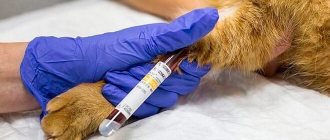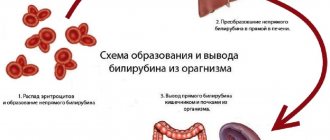Blood test interpretation
It is known that for almost all diseases, the veterinarian first takes a blood test. Many people also know that in case of infectious and inflammatory pathologies, an increased number of leukocytes is found in it. So here it is. Leukocytosis is a situation in which the level of leukocytes in the general bloodstream is increased. The reasons are different, but most often some hidden inflammatory process is to blame.
Neutrophilia or neutrophilic leukocytosis are terms that indicate an increase in the number of neutrophils. Lymphocytosis is an increase in the concentration of lymphocytes. Monocytosis, accordingly, occurs when there is an excess of monocytes. Eosinophilia occurs when the “population” of eosinophils increases, and mastocytosis begins when there is an excess of mast cells in the blood. And all this is united by the term “leukocytosis”. When and what occurs?
The most characteristic is eosinophilia, which most often occurs with helminthic infestations. If there are a lot of leukocytes of this type in the blood, look for “new arrivals” in the intestines. The same is true for basophilia. Sometimes this type of leukocytosis is observed during allergic reactions and autoimmune reactions, but worms still cause this phenomenon much more often.
But with allergies, it is mastocytosis that is most characteristic. It is the destruction of mast cells that causes a “histamine storm”, which is responsible for all the clinical signs of anaphylactic shock and a simple allergic reaction. However, this can often be observed in dangerous autoimmune pathologies!
What does an increased number of neutrophils “hint” at? At the acute stage of some infectious disease. Lymphocytosis is more typical for various types of chronic diseases of cats. Using this indicator, one can easily identify the presence of some “disguised” infections that do not manifest themselves in any way, or their symptoms are not particularly specific.
Other reasons
Oddly enough, but by the characteristics and number of leukocytes one can judge not only the presence or absence of infectious pathologies. So, there is the concept of “toxic neutrophilia”. We are talking about a sharp increase in the content of immature forms of neutrophils. This is very typical for many forms of poisoning, including chronic ones.
There are also more specific cases. For example, Chediak-Higashi syndrome. A fairly rare hereditary disease found in Persian cats. It is accompanied by an increased tendency to bleeding with or without cause, a change in the color of the iris, as well as a large number of basophils and eosinophils in the blood.
The Pelger-Huet anomaly also belongs to this group. A hereditary, genetically determined disease, characterized by the accumulation of nuclear chromatin in the cytoplasm of the same long-suffering neutrophils. This disorder was initially identified in rabbits, but scientists later found that the disease can occur in cats, dogs and humans.
Thus, the concept of “leukocytosis” is extremely broad and can be caused by tens, hundreds and even thousands of different reasons. Accordingly, the symptoms of leukocytosis in a cat are such a loose concept that it makes no sense to describe any clinical signs. To find out the exact reason why leukocytosis occurred, one blood test is not enough.
A complete examination of the animal is necessary, checking its urine, feces, ultrasound and x-ray examination. So the “treatment” of leukocytosis in cats is a rather broad definition, which can include hundreds of therapeutic methods that vary from disease to disease.
Oncology
The source of red and white blood cells is the bone marrow. Just like humans, animals can develop tissue malignancies. It affects lymphoma, myeloma and metastases of other types of oncology. If tests show that a cat’s white blood cells are low, he may suffer from one of the pathologies mentioned. The following symptoms also indicate its presence:
increased susceptibility to infections - leukocytes protect the owner from pathogens;
The final diagnosis is made based on the results of a blood test. For oncology, chemotherapy and radiation may be prescribed. If malignant cells are localized (for example, in a limb), doctors sometimes resort to amputation.
Additionally, antibiotics are used to combat panleukopenia with secondary bacterial infections, and painkillers.
Viruses
A change in the number of leukocytes can be provoked by extracellular infectious agents. Thus, bone marrow and other tissues that affect the number of white blood cells are affected by viruses:
Viral infections are currently incurable - veterinarians prescribe maintenance therapy. Its effectiveness depends on the timely initiation of treatment. So, your pet can be vaccinated against distemper, preventing infection.
Having noticed that a cat's white blood cells are low, the owner should immediately consult a veterinarian to clarify the diagnosis. A viral infection will be indicated by:
the pet's desire to hide;
decreased activity and appetite.
These are common symptoms for various conditions. It is always necessary to pay attention to them and consult with a specialist, since symptoms appear in a wide range of pathologies. Identifying any of them at an early stage will allow you to prolong and improve your pet’s life with timely treatment.
Stress
May cause an increase in the concentration of neutrophils, a type of white blood cell. There are also eosinophils, basophils, lymphocytes, granulocytes and monocytes. Stress is characterized by changes in behavior, decreased appetite, reluctance to interact with others and aggression.
If the reason is the emotional state of the cat, you should try to eliminate the irritants or minimize contact with them. So, the owner can start feeding the animal the usual food or start paying the usual amount of attention.
The latter is necessary if the cat has been neglected due to a change in family composition, moving, or the appearance of a new pet.
Inflammatory processes
With them, the cat usually has elevated leukocytes in the blood - the immune system is activated to fight foreign structures. An increase in the concentration of white blood cells in combination with inflammation causes:
- bacterial and fungal infections - leads to additional generation of neutrophils;
allergies to food and external irritants - provoke an increase in the concentration of eosinophils;
autoimmune diseases - characterized by an increase in the concentration of lymphocytes;
joint and tissue injuries.
The body responds by releasing white blood cells to various stimuli. Allergies are accompanied by salivation and lacrimation, skin irritation and breathing problems.
With hidden injuries and sprains, pain is present, causing the pet to pay increased attention to the affected area. Infections and autoimmune diseases are detected using tests.
Other diseases
There are many reasons why a cat’s white blood cells are low. In addition to those already mentioned, the list includes:
- Parasites. The body may respond by increasing BCT levels to the presence of heartworms and other worms. Their presence is indicated by weight loss, cough, rapid breathing, weakness and vomiting.
Kidney failure. May cause levels of all types of white blood cells to rise without causing other symptoms. If changes are noticed when taking a blood test for other disorders, you should immediately consult your doctor about additional examination. Symptoms of kidney failure do not appear until the condition reaches its final stages, when treatment is no longer effective.
Potassium deficiency. Causes an increase in the number of leukocytes. Accompanied by weight loss, weakness, vomiting and frequent urination. It is treated by introducing the element with food or injections (the choice is made by the veterinarian).
Congenital diseases. In particular, these include Chediak-Higashi syndrome, which affects the nuclei of all types of leukocytes. Persian cats are susceptible to the disease. It increases susceptibility to bacterial infections and bleeding tendency, accompanied by discoloration of the eyes and skin. Another inherited disorder, Pelger-Huet anomaly, is characterized by the failure of granulocytes to mature normally. In most cases, the disease is asymptomatic. But for some cats it is fatal, accompanied by skeletal deformities and increased susceptibility to infections.
Hereditary disorders are characteristic of purebred individuals. If blood tests and other examinations indicate their presence, animals should be excluded from the breeding system.
A deviation in the level of leukocytes from the norm in a cat’s blood may indicate a number of pathologies: from a cold to oncology. Some conditions are potentially fatal without timely treatment, so it is advisable for the owner to pay attention to changes.
Depending on the disease, the veterinarian will suggest treatments that relieve the pathological condition or help prolong the normal life of the cat.
Feline leukemia is one of the most dangerous incurable retroviral diseases of cats, which is dormant (hidden, sluggish) and does not manifest itself until the beginning of the terminal phase. Together with infectious peritonitis and immunodeficiency in cats, leukemia is included in the ominous list of “tri-fatal” infections, characterized by high contagiousness and lethality.
Other names for leukemia in cats are VLK, FeLV, blood cancer, leukemia, viral leukemia, Leucaemia viralis, lymphosarcoma, hemoblastosis.
low lymphocytes in a cat, how to treat it
Lymphocytes are low in a child: causes, symptoms, treatment.
Lymphocytes are white blood cells that are considered the main components of the immune system. Their formation occurs in the bone marrow. They recognize and destroy harmful bacteria and viruses that have entered the body. White blood cells also produce special antibodies that help fight infections. A low white blood cell count indicates problems in the body.
The norm of these cells is clearly defined - in children under the age of 6 years, there should be from 60 to 65% lymphocytes in the blood. For a newborn, the norm is 22-25%. In a child from 6 to 18 years old, the norm of lymphocytes is the same as in an adult - from 1000 to 3000 cells per 1 microliter of blood.
The number of these cells allows you to determine a general blood test. Doctors call a decrease in lymphocytes lymphopenia. It can be acute or chronic. There are children who get lymphopenia from their mother. This happens in some congenital diseases associated with immunodeficiency. Acquired lymphopenia is quite common. One of the most common reasons for its development is a lack of protein in the diet. The cause of the disease can be AIDS and autoimmune diseases.
Experts distinguish between relative and absolute lymphopenia. The first occurs as a result of disturbances in the lymphoid system and accelerated death of white blood cells. It can also be a consequence of a chronic or acute infectious disease. The absolute form of lymphopenia is characteristic of acquired or congenital immunodeficiency conditions. It appears against the background of leukemia, leukocytosis, exposure to radiation, chronic liver diseases, etc. Doctors note that absolute lymphopenia can occur in newborns of any postnatal and gestational age
Lymphocytes are lower
Source
lymphocytes are low in a cat reasons
Lymphocytes are low
The main function of these immune cells is the correct formation of the body’s defense response to the penetration of viruses. Therefore, it is important to pay attention to the results of a blood test and take appropriate measures if lymphocytes are reduced even slightly or their number deviates from normal values, and monitor the concentration.
Acceptable values for the level of immune cells in question are from 18 to 40%. Variations within these limits are possible due to stress, overwork; in women, fluctuations are sometimes caused by the onset of the menstrual cycle.
A reduced level of lymphocytes in the blood indicates the development of lymphopenia. This condition is characterized by the migration of the described cells from the biological fluid circulating in the vessels to the tissues where the inflammatory process begins. The following pathologies may be the causes:
It should be noted that these factors are characteristic of absolute lymphopenia. This means an almost complete absence of any type of lymphocytes in the blood.
The relative form of this condition indicates that the percentage of lymphocytes to other cell types in the leukocyte formula is disturbed. As a rule, such lymphopenia is eliminated more easily and quickly, since it is not always a sign of severe inflammatory processes.
In pregnant women, the number of lymphocytes is also often reduced. This is due to a natural mechanism that allows the egg to be fertilized. Otherwise (while maintaining a normal level of immune cells), lymphocytes would perceive male genes as foreign and, accordingly, would contribute to the formation of an aggressive response, blocking their penetration, and therefore excluding the possibility of pregnancy.
Lymphocytes in the blood are reduced
Number of lymphocytes in the periphery
Source
Leukocyte formula: what is it?
The percentage of types of leukocytes from their total number is called the excretion of the leukocyte formula. It helps to judge the nature of the pathogenic process and has specific differences in infections and parasitic diseases.
It is clear that there is no strict relationship between a specific disease and changes in the leukocyte formula from the norm. That is, it is impossible to make a definite and unshakable diagnosis purely from a blood picture. Therefore, the existing symptom complex is always compared and the results of other studies are taken into account.
Formed elements are usually divided into three groups: erythrocytes, leukocytes and blood platelets. The total volume of cells in 100 volumes of biological fluid is called hematocrit.
In the past, counting was done visually:
- a smear was made from the blood;
- it was dried and painted with special dyes;
- after that, under a microscope in 100 fields of view, the number of certain cells was counted and the leukoformula was derived by simple calculations.
Today the process has been significantly simplified - special devices (hemolytic analyzers) have been created that produce a ready result in a couple of minutes. In addition, they know how to calculate ESR (erythrocyte sedimentation rate) - another important indicator when assessing the general condition of the body.
Increased lymphocytes in the blood, what does this mean in an adult?
So, we all know that our health needs to be protected. We sometimes get sick and, almost constantly, we use folk remedies or other medicines that ease our pain and heal. But we never thought that our main panacea is the immune system.
Immunity is a human barrier that does not allow foreign bacteria to enter the territory of our body. But if it so happens that the disease has penetrated inside us, then the immune system is actively trying to overcome the causes of the infection.
The most important representatives of our immune system are Lymphocytes - these are cells that contribute to the production of antibodies and also control cellular machinery. An excess of such seemingly “useful” cells is a very sad sign that can lead to bad consequences.
What are elevated lymphocytes in the blood?
Lymphocytosis is a significant increase in lymphocytes in the blood. It is divided into two subgroups: relative and absolute. Relative - a condition in which the amount of such substances in a person’s blood exceeds the norm (due to age). In adults over 30 years of age, this condition is noted when deciphering the level of white cells, the result should be a number higher than 4 * 10^9 cells / liter of blood (look at the number of zosinophils per liter of blood). Absolute lymphocytosis is basically the percentage of their number per liter of blood. This number also includes hemoglobin, zosinophils, monocytes, basophils and neutrophils. The percentage can be lower or higher, but the norm is considered to be 19 - 20%. In any case, when collecting tests, the doctor first looks at the number of lymphocytes in the blood.
Increased lymphocytes in the blood, what does this mean in an adult?
The main “vehicle” for “defenders” is blood.
Source
segmented cells are elevated in a cat, what is it?
Lymphocytes in a blood test
Thanks to modern medical diagnostic methods, specialists can judge the health status of any patient. This is usually done on the basis of numerous laboratory studies of biological material. Each type of biological material is assessed in accordance with certain parameters, from which a conclusion is made about a possible pathological process in the body.
Among these indicators, there are very important and significant ones, and there are minor ones that are necessary to create a more detailed picture. One of these important indicators is the level of lymphocytes in the blood. It, along with several other blood indicators, is assessed by a specialist first. What are lymphocytes, and why is it so important that their level in the blood is normal?
Lymphocytes are cells involved in the body's immune defense. They are a type of leukocyte - white blood cells. The main function of lymphocytes is to detect pathogens of infectious diseases, tumor cells, fungi, etc. and destroy them. Lymphocytes are formed in the bone marrow, from where they enter the blood.
After this, 70-80% of the lymphocytes enter the thymus (thymus gland), where they are converted into T lymphocytes. These cells are directly involved in recognizing microbes and thereby forming the body's immune response. The remaining part of the lymphocytes, which is 10-15%, become B lymphocytes. The function of these cells is reduced to the direct destruction of “enemy” cells, since upon contact with them, B lymphocytes release antibodies that destroy them.
The third type of lymphocyte is called NK lymphocyte. They make up approximately 5-10% of the total lymphocyte volume. This type of lymphocyte provides antitumor protection
Source
What are they researching for?
In almost any pathological process, a clinical blood test is performed first, which includes:
- study of the morphological features of formed elements (red and white blood cells), their qualitative and quantitative composition;
- determination of physical and chemical properties: density, color, viscosity, osmosis, alkaline reserve, etc.;
- analysis of biochemical composition: glucose, protein, albumin, urea, creatinine, etc. (we will consider this item in a separate article).
In the first case, uncoagulated (whole) blood is delivered to the laboratory; in the second case, serum is used (in other words, the upper layer formed when biological fluid settles).
According to indications, other types of blood or serum tests are also carried out, the purpose of which is:
- detect a specific pathogen, for example, with hemobartonellosis or piroplasmosis;
- determine the presence of antibodies to microorganisms or toxins (ELISA, PCR, serology);
- isolate the pathogen by bacteriological culture;
- study hormonal levels, etc.
Lymphocytes are elevated in a cat, what does this mean?
If lymphocytes are elevated in the blood, what does this mean?
If a person has elevated lymphocytes in the blood, what does this mean, they often ask the doctor. There are many reasons for this, but they are all some kind of disease. An increase in lymphocytes may indicate the development of an inflammatory process in the body, and where the greatest accumulation of these blood cells is, there is a source of infection. Lymphocytes are white blood cells of the body that provide human immunity and protect him from infections.
The number of lymphocytes is constant, their number increases with age, in other cases we can talk about infectious inflammation in the body. In addition to white cells, there are also red cells in the blood - erythrocytes. Their function is to deliver oxygen to tissues and organs. Their amount in the blood shows the level of hemoglobin, the deficiency of which causes anemia and sometimes more severe conditions.
The role of all blood cells in the body is invaluable. White blood cells can regulate antibody production, speeding it up or slowing it down, and are involved in recognizing foreign particles and getting rid of abnormal cells. Red blood cells are responsible for saturating tissues with oxygen.
Lymphocytes are white blood cells responsible for the body's immune defense. We can assume that these are leukocytes, only of a different type. Lymphocytes make up about 30% of the total number of white cells, in addition to them there is a variety called neutrophils. These cells can account for up to 47-70% of all leukocytes. Morphologically, these cells are divided into small and large. By functionality, T-lymphocytes, NK and B-cells.
I will give you the dawn, the moon and stars, moonlight. And the breeze blows like this
NK cells control the quality of other cells in the body and rid it of atypical cellular formations. B-group cells are responsible for the production of antibodies and recognition of foreign particles.
Source
A child has increased lymphocytes in the blood: what does this mean and what are the reasons for the increase in the number of white cells?
When the level of white cells is elevated, this means that a pathological process is occurring in the body or that physiological factors are affecting the child’s condition.
Increased lymphocytes: what does this mean?
The contents of the vessels are represented by two types of lymphocyte cells. One is produced by the thymus gland, and the second by the bone marrow. Each of them is responsible for certain functions in the child’s body related to maintaining immunity .
The first group of cells is directly related to it, fighting viruses. It helps destroy foreign microorganisms. The second group circulates from the vessels to neighboring tissues and undergoes a transformation process there in order to carry out a local protective function. With the help of these blood elements, the synthesis of antibodies is triggered, preventing the introduction and subsequent growth of bacteria.
When the level of lymphocytes is elevated, this means that the baby’s body is fighting an infection or inflammatory process, or is already in a stage close to recovery.
At this moment, the immune system is trying to cope with an external threat - pathogenic microorganisms. Sometimes excess of the norm is observed after the illness, when the affected systems or organs are just beginning to recover.
How to identify pathology?
Outwardly, it does not manifest itself in any way, especially in infants. In rare cases, the body temperature rises, the child is more often capricious. Basically, it is possible to determine that the concentration of lymphocytes is increased only by test results. In order to understand what indicators are considered alarming, you need to know what the child’s white blood cell count is. It differs significantly from the standards provided for adults.
Reasons for exceeding
Source
Can a person get infected from a cat?
Numerous studies prove that it is impossible to become infected with leukemia from cats . In the human body there is nothing for it to “catch onto”, since the DNA of a cat and a person do not have identical areas vulnerable to the virus. In addition, human leukemia has a completely different, non-viral nature.
Feline leukemia is not dangerous for dogs either.
Therefore, you should not be afraid to take such an animal into your home as the only one that purrs, or in the company of a carrier of the same virus.
Why are lymphocytes in the blood low?
Lymphocytes are blood cells belonging to the group of leukocytes. These essential elements of the immune system are produced in the bone marrow, spleen, lymph nodes, appendix, tonsils, and thymus. They are small in size, their cytoplasm is devoid of granularity, and the nucleus occupies a significant part of the cell. Approximately 2% of all lymphocytes are found in the blood, the rest are found in tissues.
The main role of these cells is to provide immune protection. They have the ability to remember antigens (foreign structures), recognize them the next time they encounter them, and produce antibodies against them. This is how immunity against infectious diseases is formed.
B-lymphocytes are responsible for humoral immunity. They recognize harmful proteins, produce antibodies, and also show neutrophils and basophils “enemies” that need to be destroyed.
T-lymphocytes are responsible for cellular immunity (directly in contact with “victims”) and regulate the immune response. Killer T cells recognize and destroy body cells damaged by intracellular pathogens. T-helpers stimulate the production of antibodies, T-suppressors, on the contrary, inhibit and thereby weaken the immune response.
NK lymphocytes - natural killer cells - destroy cells that do not correspond to the norm, that is, they have changed their structure (for example, tumor cells).
Thus, it can be concluded that normal levels of lymphocytes in the blood are very important for providing protection against disease. Deviations in any direction indicate pathology.
Lymphocyte norms
The level of these cells is determined during a clinical blood test. Both absolute and relative quantities are calculated. Lymphocyte norms depend on age.
Reasons for the low level
A condition in which lymphocytes in the blood are low and their number is less than 1X10⁹/l
A general blood test in cats gives a general idea of the physiological state of the body; the number of formed elements in the blood allows you to see the condition of the body as a whole. In addition, with a general blood test in a cat, it is possible to determine the presence of blood parasites, such as heartworms and hemobartenella. To carry out this test, venous blood is taken from the cat and placed in a special tube with an anticoagulant, which prevents blood clotting and the destruction of blood cells. There are standards that the results of a general blood test must meet, and deviations from this standard may indicate the presence of specific diseases.
So, the general norms for the results of a general blood test in a cat are as follows:
- Hematocrit - from 26 to 48%, an upward deviation indicates cardiac or pulmonary failure and erythremia;
- Hemoglobin - from 80 to 150 g/l, elevated hemoglobin levels may indicate dehydration of the body, some forms of hemoblastosis, for example, erythremia, a reduced level of hemoglobin in the blood of a cat indicates the presence of various types of anemia, possibly due to blood loss;
- Red blood cells - from 5.3 to 10 x 106 / ml, an increased level of red blood cells indicates erythremia, chronic lung diseases, heart failure, an increased diameter of red blood cells indicates dehydration of the body, lower levels also indicate anemia; An increase in the diameter of erythrocytes indicates a deficiency of vitamin B12 and folate deficiency anemia, liver disease; a small diameter indicates a deficiency of iron in the cat’s body and hemolytic anemia.
- Color index – from 0.65 to 0.9;
- ESR – from 0 to 13 mm/h, an increase in ESR means that inflammatory processes have begun in the cat’s body, poisoning or infection is possible, it is also a signal of tumors, invasions, an increase is considered normal after surgery or after injuries;
A biochemical blood test in cats is a very important way to diagnose possible pathological conditions of the animal. This test requires blood serum and provides a picture of enzyme activity in the body. Assessing the activity of enzymes makes it possible to understand which organs of the cat are affected and the degree of damage to a particular organ. In addition to enzyme analysis, during a biochemical blood test in cats, the amount of substrates, fats and electrolytes in the blood serum is examined. When performing a comprehensive analysis of a cat’s health, this stage of analysis is one of the most important.
Blood for analysis is taken on an empty stomach from a vein and placed in a special test tube, which makes it possible to separate the serum. There are certain norms for indicators of the results of biochemical analysis; deviation from these norms in any direction may indicate the presence of diseases in the cat.
The basic norms for indicators in a biochemical blood test are as follows:
- glucose - from 3.3 to 6.3 mmol/l, increased glucose levels are observed with diabetes mellitus, stress, pancreatic necrosis, as well as with hyperthyroidism and hyperadrenocorticism, reduced levels are characteristic of insulin overdose, hypoadrenocorticism and insulinoma;
- protein - from 54 to 77 g/l, increased protein levels are observed in chronic inflammatory diseases, dehydration, autoimmune diseases and some forms of hemoblastosis, decreased protein indicates nephrotic syndrome, pancreatitis, enteritis, heart failure, hypovataminosis, also characteristic of burns, starvation and malignant formations;
- albumin – from 25 to 37 g/l, albumin indicators correlate with protein levels;
- cholesterol – from 1.3 to 3.7 mmol/l, elevated cholesterol levels indicate the presence of hypothyroidism, diabetes mellitus, pancreatitis;
- total bilirubin – from 3 to 12 µmol/l, an enzyme that is not processed by the liver, an increase indicates vitamin B12 hypovitaminosis;
Electrolyte levels must meet the following standards:
- Potassium - from 4.1 to 5.4 mmol/l, elevated readings of this electrolyte indicate dysfunction of the thyroid gland, tumor, periostitis, renal failure, decreased readings are observed during fasting, vitamin D hypovitaminosis, chronic liver failure,
- Sodium – from 143 to 165 mmol/l;
- Calcium – from 2 to 2.7 mmol/l;
- Iron – from 20 to 30 mmol/l;
- Chlorine – from 107 to 122 mmol/l;
- Phosphorus - from 1.1 to 2.3 mmol/l, an increased deviation from the norm indicates hypothyroidism, renal failure, lower levels indicate diabetes mellitus.
Clinical significance of UAC indicators
Currently, most indicators are determined on automatic hematology analyzers, which allow simultaneous examination of from 5 to 36 parameters, which provides a lot of additional information.
LEUCOCYTES (WBC) are produced in the red bone marrow and lymph nodes. Leukocytes include cells of the granulocytic (neutrophils, eosinophils, basophils), monocytic (monocytes) and lymphoid (lymphocytes) series.
The main function of leukocytes is to protect the body from foreign agents. Immunological reactions are realized due to the phagocytic activity of leukocytes, their participation in cellular and humoral immunity, and histamine metabolism.
Reference intervals:
dogs – 6.0 – 16.9 x 109 /l;
cats – 5.5 – 19.5 x 109 /l;
Leukocytosis is an increase in the number of white blood cells above normal limits.
Physiological leukocytosis:
- fear;
- excitation;
- rough treatment;
- physical exercise;
- convulsions.
Stress leukocytosis:
- injuries;
- surgical operations;
- attacks of pain;
- malignant neoplasms;
- spontaneous or iatrogenic Cushing's disease;
- second half of pregnancy (physiological with a shift to the right).
Inflammatory leukocytosis:
- infections (bacterial, fungal, viral, etc.);
- injuries;
- necrosis;
- allergies;
- bleeding;
- hemolysis;
- inflammatory conditions;
- acute local purulent processes.
Inappropriate reactions of leukocytes:
- severe purulent infections;
- gram-negative sepsis.
Leukopenia is a decrease in the number of leukocytes below normal limits.
Decrease in the number of leukocytes as a result of decreased hematopoiesis:
- infection with feline leukemia virus (cats);
- infection with feline immunodeficiency virus (cats);
- feline viral enteritis (cats);
- parvovirus enteritis (dogs);
- feline panleukopenia;
- hypoplasia and aplasia of bone marrow;
- damage to the bone marrow by chemicals, drugs, etc.
- myeloproliferative diseases;
- myelophthisis;
- taking cytotoxic drugs;
- ionizing radiation;
- acute leukemia;
- metastases of neoplasms to the bone marrow;
- cyclic leukopenia in marbled blue collies (hereditary, associated with cyclic hematopoiesis).
Leukocyte sequestration:
- endotoxic shock;
- septic shock;
- anaphylactic shock.
Increased utilization of leukocytes:
- gram-negative sepsis;
- endotoxic or septic shock;
- viremia;
- severe purulent infections;
- toxoplasmosis (cats).
Increased destruction of leukocytes:
- gram-negative sepsis;
- endotoxic or septic shock;
- DIC syndrome;
- hypersplenism (primary, secondary);
- immune-related leukopenia.
Result of the drugs:
- sulfonamides;
- some antibiotics;
- non-steroidal anti-inflammatory drugs;
- thyreostatics;
- antiepileptic drugs;
- antispasmodic oral drugs.
A decrease or increase in leukocytes in the blood may be due to certain types of leukocytes. An increase or decrease in the number of certain types of leukocytes in the blood can be absolute (with a decrease or increase in the total leukocyte content) or relative (with a normal total leukocyte content).
Leukocyte formula is the percentage of different types of leukocytes in a blood smear. It has great diagnostic value.
Neutrophils in peripheral blood are represented by segmented and a relatively small number of band forms. The main function of these cells is to protect the body from infections; their main property is the ability to phagocytose.
Neutrophilia – increased number of neutophils:
Physiological:
- excitation;
- fright;
- physical exercise.
Stressful:
- pain;
- prolonged stress;
- Cushing's syndrome.
Inflammatory:
- bacterial infections (sepsis, pyometra, peritonitis, abscesses, pneumonia, etc.);
- inflammation or tissue necrosis (rheumatoid attack, heart attacks, gangrene, burns);
- progressive tumor with decay;
- acute and chronic leukemia;
- exogenous intoxication (the result of the action of poisons of insects, snakes, endotoxins, vaccines, medications);
- acute hemorrhages;
- parasitic diseases;
- endogenous intoxications (uremia, ketoacidosis, eclampsia, etc.);
- hereditary pathologies;
- increase in carbon dioxide concentration.
Neutropenia is a decrease in the number of neutrophils.
Causes:
- viral (canine distemper, feline panleukopenia, parvovirus gastroenteritis, etc.)
- some bacterial infections (salmonellosis, brucellosis, tuberculosis, bacterial endocarditis, other chronic infections);
- infections caused by protozoa, fungi, rickettsia;
- aplasia and hypoplasia of the bone marrow, metastases of neoplasms in the bone marrow;
- ionizing radiation;
- hypersplenism (splenomegaly);
- aleukemic forms of leukemia;
- anaphylactic shock;
- collagenoses;
- hereditary forms;
- the use of sulfonamides, analgesics, anticonvulsants, antithyroid and other drugs.
Agranulocytosis is a sharp decrease in the number of granulocytes in the peripheral blood until their complete disappearance, leading to a decrease in the body's resistance to infection and the development of bacterial complications.
Leukemoid reaction of the neutrophil type is a sharp increase in the number of neutrophil leukocytes in the blood with the appearance of a large number of hematopoietic elements, up to myeloblasts.
Causes:
- acute bacterial pneumonia;
- malignant tumors with multiple metastases to the bone marrow.
Eosinophils are blood cells that phagocytose antigen-antibody complexes. Participate in immediate and delayed hypersensitivity reactions.
Eosinophilia is an increase in eosinophils in the blood. Most often accompanies parasitic infestations and atopic diseases.
The most common reasons:
- allergies;
- parasitic diseases;
- drug intolerance;
- eosinophilic granulomas;
- eosinophilic leukemia;
- inflammatory reactions in organs that normally contain a large number of mast cells (skin, lungs, intestines, uterus).
Eosinopenia - a decrease in the content of eosinophils - is in most cases caused by an increase in adrenocorticoid activity. The concept is relative, since they may not be normally present in healthy animals.
Basophils are blood cells containing histamine granules in the cytoplasm. The main function of these cells is to participate in immediate-type hypersensitivity reactions, as well as in inflammatory, allergic and delayed-type hypersensitivity reactions.
Basophilia is an increase in basophils in the blood.
- allergic reactions to the introduction of a foreign protein, including allergies to food;
- chronic inflammatory processes in the gastrointestinal tract;
- blood diseases (acute leukemia, lymphogranulomatosis);
- myxedema (hypothyroidism);
- lipid metabolism disorder;
- the result of the action of estrogens and antithyroid drugs.
Lymphocytes are a central link in specific immunological reactions. The main function is to recognize the antigen and participate in an adequate immune response of the body. T lymphocytes determine cellular immunity. B lymphocytes participate in humoral immunity and differentiate into plasma cells that secrete immunoglobulins in response to stimulation by foreign antigens. They actively participate in the pathogenesis of immunodeficiency conditions, infectious, allergic, lymphoproliferative, oncological diseases, and autoimmune processes.
Absolute lymphocytosis is an increase in the number of lymphocytes in the blood.
- viral infections;
- chronic allergic reactions;
- reaction to vaccination in young dogs;
- blood diseases (lymphocytic leukemia, lymphosarcoma);
- toxoplasmosis;
- hyperthyroidism;
- the use of non-steroidal anti-inflammatory drugs (NSAIDs), griseofulvin, haloperidol, etc.;
- relative lymphocytosis with neutropenia.
Absolute lymphopenia is a decrease in the number of lymphocytes in the blood.
- pancytopenia;
- use of corticosteroids, immunosuppressants;
- malignant neoplasms;
- immunodeficiency states;
- renal failure;
- chronic liver diseases;
- loss of lymphocyte-rich lymph;
- circulatory failure.
Monocytes are cells belonging to the mononuclear phagocyte system (MPS). Removes dying cells, denatured protein, bacteria and antigen-antibody complexes from the body.
Monocytosis is an increase in the number of blood monocytes.
- infections (viral, fungal, rickettsial, protozoal);
- blood parasitic diseases (pyroplasmoidosis, including canine babesiosis);
- acute and chronic inflammatory processes;
- collagenoses;
- blood diseases;
- tissue inflammatory processes;
- granulomatosis (tuberculosis, brucellosis, ulcerative colitis, enteritis);
- surgical interventions.
Monocytopenia—decreased number of monocytes. It is difficult to assess due to the low level of monocytes in the blood under normal conditions.
HEMOGLOBIN (HGB) is the main component of red blood cells. The main function of HGB is the transfer of oxygen from the lungs to the tissues, as well as the removal of carbon dioxide from the body and the regulation of acid-base status. HGB concentration is the main indicator in the diagnosis of anemia.
dogs – 120 – 180 g/l;
cats – 80 – 150 g/l;
Reasons for the increase:
- primary and secondary erythrocytosis;
- excessive exercise or agitation;
- relative erythrocytosis during dehydration;
Reasons for downgrade:
- anemia (iron deficiency, hemolytic, hypoplastic, B12-folate deficiency);
- acute blood loss (on the first day of blood loss due to blood thickening caused by large loss of fluid, the hemoglobin concentration does not correspond to the picture of true anemia);
- hidden bleeding;
- endogenous intoxication (malignant tumors and their metastases);
- damage to the bone marrow, kidneys and some other organs;
- hemodilution (intravenous fluids, false anemia).
Reasons for a false increase in hemoglobin:
- high leukocytosis;
- progressive liver diseases;
- multiple myeloma.
HEMATOCRIT (HCT) is the volume fraction of formed elements in whole blood. The second most important indicator of a general blood test after HGB, showing the severity of anemia. This is an approximate indicator of hemoconcentration shifts and hemodilution.
dogs – 37 – 55%;
cats – 25 – 45%.
Reasons for the increase:
- primary and secondary erythrocytosis (increased number of red blood cells);
- dehydration (gastrointestinal diseases accompanied by profuse diarrhea, vomiting; diabetes);
- decrease in the volume of circulating plasma (peritonitis, burn disease);
Reasons for downgrade:
- anemia;
- increased circulating plasma volume (heart and kidney failure, hyperproteinemia);
- chronic inflammatory process, trauma, fasting, chronic hyperazotemia, cancer;
- hemodilution (intravenous administration of fluids, especially with reduced renal function).
ERYTHROCYTES (RBC) are the most numerous representatives of the formed elements of blood. Red blood cells contain HGB. The main function of red blood cells is to supply tissues with oxygen and remove carbon dioxide from them. They are formed from reticulocytes as they exit the red bone marrow. The reticulocyte finally matures within a few hours.
Reference intervals:
dogs – 5.5 – 8.5 x 1012 /l;
cats – 5.0 – 11.0 x 1012 /l;
Erythrocytosis is an increase in the number of red blood cells, which can be absolute or relative.
Relative erythrocytosis - due to a decrease in circulating blood volume or the release of red blood cells from blood depots.
- excitation;
- exercise stress;
- pain;
- fluid loss (diarrhea, vomiting, excessive diuresis, excessive sweating);
- drinking deprivation;
- increased vascular permeability with the release of fluid and proteins into the tissue.
Absolute erythrocytosis is an increase in the mass of circulating red blood cells due to increased hematopoiesis.
Erythremia is primary erythrocytosis, resulting from the autonomous (independent of the production of erythropoietin) proliferation of erythroid progenitor cells in the red bone marrow and the entry into the blood of a large number of mature red blood cells.
Symptomatic erythrocytosis caused by hypoxia:
- lung diseases;
- heart defects;
- presence of abnormal hemoglobins;
- increased physical activity;
- staying at high altitudes above sea level;
- obesity;
- chronic methemoglobinemia (rare).
Symptomatic erythrocytosis associated with inappropriately increased production of erythropoietin:
- hydronephrosis and polycystic kidney disease (with local hypoxia of kidney tissue);
- kidney parenchyma cancer (produces erythropoietin);
- liver parenchyma cancer (produces erythropoietin-like proteins).
Symptomatic erythrocytosis associated with an excess of adrenocorticosteroids or androgens in the body:
- Cushing's syndrome;
- pheochromocytoma;
- hyperaldesteronism.
Erythrocytopenia is a decrease in the number of red blood cells in the blood.
- Anemia of various origins.
- Increased circulating blood volume (relative anemia):
- overhydration;
- sequestration of red blood cells in the spleen;
- hyperproteinemia;
- hemodelution (blood dilution) in case of advanced expansion of the vascular space and distribution of the total red blood cell mass in the body (anemia of newborns, anemia of pregnant women);
- increased concentration of cytotoxic estrogens in functioning cystic ovaries (dogs).
- Infectious agents:
- Ehrlichia canis (dogs);
- parvovirus (dogs);
- infection with feline leukemia virus (FLV infection);
- panleukopenia (cats – rare);
- infection with feline immunodeficiency virus (FIV infection).
- Immune-mediated - idiopathic aplastic anemia.
- Radiation therapy.
- Myelophthisis (a disorder characterized by the replacement of hematopoietic cells with abnormal cells):
- myelogenous leukemia;
- lymphoid leukemia;
- multiple myeloma;
- myelodysplastic syndromes;
- myelofibrosis;
- osteosclerosis;
- metastatic lymphomas;
- metastatic mast cell tumors.
Classification of anemia according to erythrocyte parameters, taking into account the mean erythrocyte volume (MCV) and the mean hemoglobin concentration in the cell (MCHC)
Normocytic normochromic anemia:
- acute hemolysis in the first 1-4 days;
- acute bleeding in the first 1-4 days;
- moderate blood loss that does not stimulate a significant response from the bone marrow;
- early period of iron deficiency;
- chronic inflammation;
- chronic neoplasia;
- chronic kidney disease (with insufficient production of erythropoietin);
- endocrine insufficiency (hypofunction of the pituitary gland, adrenal glands, thyroid gland or sex hormones);
- selective erythroid aplasia;
- aplasia and hypoplasia of the bone marrow of various origins;
- lead poisoning;
- lack of cobalamin (vitamin B12).
Macrocytic normochromic anemia:
- regenerative anemia;
- for infections caused by feline leukemia virus;
- erythroleukemia and myelodysplastic syndromes;
- non-regenerative immune system-mediated anemia;
- macrocytosis in poodles (healthy mini-poodles without anemia);
- cats with hyperthyroidism (weak macrocytosis without anemia);
- folate deficiency.
Macrocytic hypochromic anemia:
- regenerative anemia with noticeable reticulocytosis;
- hereditary stomatocytosis in dogs;
- increased osmotic instability of erythrocytes of Abyssinian and Somali cats.
Microcytic or normocytic hypochromic anemia:
- chronic iron deficiency;
- portosystemic shunts;
- anemia in inflammatory diseases;
- hepatic lipidosis in cats;
- normal condition for Japanese Great Danes, Akitas and Shibas;
- long-term treatment with recombinant human erythropoietin;
- copper deficiency;
- drugs or agents that inhibit heme synthesis;
- myeloproliferative disorders with impaired iron metabolism;
- pyridoxine deficiency;
- familial disorder of erythropoiesis in English springer spaniels.
MEAN ERYTHROCYTE VOLUME (MCV) is an indicator used to characterize the type of anemia. The MCV value within the normal range characterizes the erythrocyte as a normocyte, less than normal as a microcyte, more than the normal range as a macrocyte
dogs – 60–72 fL
cats – 39 – 50 fL;
Increased (macrocytosis):
- macrocytic and megaloblastic anemia (B12-folate deficiency);
- anemia that may be accompanied by macrocytosis (hemolytic);
- healthy greyhounds;
- congenital macrocytosis in poodles;
- regenerative anemia;
Decreased (microcytosis):
- microcytic anemia (iron deficiency, sideroblastic, thalassemia);
- anemia that is accompanied by microcytosis (hemolytic, hemoglobinopathies);
- portosystemic anastomoses and lipidosis in cats;
- liver failure;
- healthy dogs of Asian breeds (Shiba Inu, Akita, Jindo);
- young animals;
- hypertensive characteristics of water-salt imbalance.
AVERAGE CONTENT OF HEMOGLOBIN IN AN INDIVIDUAL ERYTHROCYTE (MCH) - this indicator has no independent significance, since it directly depends on the average volume of the erythrocyte (MCV) and the average concentration of hemoglobin in the erythrocyte (MCHC).
dogs – 19.5 – 25.5 Pg
Cats –12.5 – 17.5 Pg
Increased:
- hyperchromic anemia (megaloblastic, liver cirrhosis);
- lipemia;
- Heinz bodies;
- pronounced leukocytosis.
Downgraded:
- hypochromic anemia (iron deficiency);
- reticulocytosis;
- anemia in malignant tumors.
INDICATOR OF ANISOCYTOSIS OF RED CYTES (RDW) – coefficient of variation in the distribution of erythrocytes by volume. A condition in which red blood cells of different sizes are simultaneously detected (anisocytosis).
Dogs – 11.0 – 16.0%;
Cats – 13.5 – 18.0%;
- macrocytic anemia;
- myelodysplastic syndromes;
- metastases of neoplasms to the bone marrow;
- iron deficiency anemia.
AVERAGE CONCENTRATION OF HEMOGLOBIN IN erythrocytes (MCHC) – reflects the relative content of HGB in the erythrocyte.
Reference intervals:
dogs – 320-385 g/l
cats – 310 – 385 g/l
Increased MSHC (extremely rare) – reasons:
- hyperchromic anemia (spherocytosis, ovalocytosis);
- hyperosmolar disturbances of water and electrolyte metabolism.
False increase in MSHC (artifact) – reasons:
- hemolysis of erythrocytes in vivo and in vitro;.
- lipemia;
- the presence of Heinz bodies in erythrocytes;
- agglutination of erythrocytes in the presence of cold agglutinins.
Decrease in MCHC reasons:
- regenerative anemia (if there are a lot of stressed reticulocytes in the blood);
- chronic iron deficiency anemia;
- hereditary stomatocytosis (dogs);
- hypoosmolar disturbances of water and electrolyte metabolism.
False decrease in MSHC – in dogs and cats with hypernatremia.
PLATELETS (PLT) are a formed element of blood, part of the cytoplasm of bone marrow megakaryocytes. Platelets perform angiotrophic, adhesive-aggregation functions, participate in the processes of blood coagulation and fibrinolysis, and ensure retraction of a blood clot. A decrease in the number of platelets in the blood (thrombocytopenia) can be caused by a decrease in their formation (hematopoietic insufficiency), an increase in their destruction or sequestration, as well as increased consumption.
dogs – 200 – 500 x 109 /l;
cats – 300 – 700 x 109 /l;
Thrombocytosis - an increase in the number of platelets can be primary (the result of primary proliferation of megakaryocytes) and secondary (reactive), occurring against the background of any disease.
- myeloproliferative processes (erythremia, myelofibrosis);
- chronic inflammatory diseases;
- malignant neoplasms;
- bleeding, hemolytic anemia;
- after surgical operations;
- after splenectomy;
- use of corticosteroids.
Thrombocytopenia - a decrease in the number of platelets in the blood can be caused by a decrease in their formation (hematopoietic insufficiency), an increase in their destruction or sequestration, as well as increased consumption.
- hereditary thrombocytopenia;
- DIC syndrome;
- bone marrow damage;
- infections;
- thromboembolic disease;
- hypersplenism;
- vasculitis;
- immune-related diseases;
- radiation therapy;
- the use of antihistamines, antibiotics, diuretics, anticonvulsants, Vicasol, heparin, digitalis preparations, nitrites, estrogens, etc.
More detailed information on taking a general blood test and the results of the study can be obtained in our clinics in Vitebsk and St. Petersburg at the Veterinary Center of Dr. Bazylevsky A.A.
If there are a lot of lymphocytes in the blood test
Lymphocytes are blood cells that are part of the immune system.
Their function is to circulate in the blood and tissues to provide immune protection against foreign agents entering the body.
If the number of lymphocytes in the blood increases, there are many of them, then they speak of lymphocytosis. Its causes may include common infections such as whooping cough and mononucleosis, or non-infectious diseases such as lymphoproliferative conditions such as chronic lymphocytic leukemia.
Norm of lymphocytes
When we receive a blood test that indicates the leukocyte formula of the blood, we are dealing with relative indicators. To accurately determine the number of lymphocytes in a volumetric unit of blood (in μl), you need to make a simple calculation:
In adults, lymphocytosis is defined as a cell count greater than >4,000/µL (this may also be expressed as: >4,000/mm3 or >4.0 x 10(9)/L).
Lymphocytes found in the blood are made up of different groups of cells called T cells, B cells, and natural killer (NK) cells. These groups of cells have different functional responsibilities in ensuring the body's normal immune defense.
When a hematologist first sees a patient's blood test with an elevated level of lymphocytes,
The first question that needs to be answered quickly is whether these changes are reactive, that is, the increase in lymphocytes is associated with the body’s reaction to external influences, or malignant.
Reactive lymphocytosis means the reaction of the immune system to any disease or condition occurring in the body. This reaction should resolve within 1-2 months after the cessation of the action of the factor causing it. An example of reactive lymphocytosis could be lymphocytosis caused by infection
Source
What do elevated leukocytes in the blood of children indicate?
The level of leukocytes in a person’s blood indicates his vitality and the body’s ability to respond to infections. These blood cells are involved in tissue repair and immune responses. In general, the number of leukocytes changes many times throughout the day. This happens due to meals, stress, and physical activity. That is why it is customary to take a blood test in the morning. There are cases when the test result shows elevated leukocytes in the blood. In children, the level of these cells is always higher than in adults. If your child’s leukocytes exceed even the established children’s norm, then you should seek help from a doctor. This circumstance may indicate the presence of a disease. This article will tell you what elevated leukocytes in the blood of children mean. So, let's begin.
The norm for these cells for adults is 4-8.8 x 109/l. In children, as mentioned above, the level of leukocytes is much higher. So, in general, the upper limit of these cells is 17 x 109/l. If the analysis showed that your child’s leukocyte level exceeds the specified level, then this may indicate the presence of diseases such as viral infections, acute bacterial diseases, allergies, inflammation, injuries, purulent processes, internal bleeding. In addition, a similar circumstance often occurs with burns and shocks, renal colic, and diabetic coma. Also, elevated leukocytes in the blood of children may indicate more dangerous diseases, such as lymphoma. You shouldn’t beat yourself up; it’s better to visit a doctor with your child who can establish an accurate diagnosis and also offer medication treatment.
If an increase in the level of these blood cells indicates the presence of an inflammatory process in the body, then to correct it with
Source
What does a veterinarian's examination of a cat with panleukopenia show?
An animal can become infected with feline distemper on the street, through contact with another cat that has passed the incubation period.
But it is important for pet owners to know how to recognize a dangerous disease and what the signs of the virus are. Panleukemia can occur in several forms - severe, moderate, mild.
The form is determined by the symptoms, behavior of the animal, and its condition. Signs of plague - vomiting, diarrhea, fever - can be expressed in varying degrees of severity.
- With a mild form, the animal may behave apathetically and eat poorly. Loose stools are also observed. Rarely there is vomiting or abdominal pain. If the cat's illness is mild, he will return to normal in a few days. One can hope that a good appetite will soon be restored and the stool will become normal. But we must not forget that after infection a pet can suffer distemper; it is better to exclude its contact with other cats.
- The disease, which occurs in a moderate form, is more severe stress for the cat’s body. After all, he will now vomit (up to 5 times a day) and suffer from frequent diarrhea. Only after a week can recovery occur if the body does not suffer catastrophically from dehydration.
ATTENTION! The disease is severe in its acute form. At first, the owner of a kitten or adult can only observe the apathetic behavior of the animal. Even to delicious cat delicacies, complete indifference remains. The cat does not drink water and does not make contact with humans. Later, such a characteristic symptom as profuse drooling appears. The temperature is very high, reaching a critical level of 41 degrees.
The animal experiences the acute form of the disease very hard. Feline distemper debilitates the cat's body with high fever and vomiting. The food is not completely digested in the stomach and also comes out with mucus. This condition, complicated by fever, can last for 12-14 hours. Qualified help from a veterinarian is required; it is very difficult to cope with a serious illness on your own, at home.
Only a specialist knows how to treat the disease competently and effectively. Therefore, you need to contact him if your pet shows even the first signs of illness.
We invite you to read: Peculiarities of a cat’s life during repairs
The owner of the cat should be alerted by the appearance of vomiting in the animal, diarrhea, in which the feces have an unusual appearance and come out in the form of a foul-smelling slurry with blood.
Even if the vomiting has stopped, this does not mean that the cat’s condition has improved. She won't drink water, and this (combined with diarrhea) will lead to dangerous dehydration.
You can notice how the behavior of the kitten has changed; it tries to hide in the darkness and does not want to move.
Sometimes cat owners calm down on the second day due to the fact that vomiting and diarrhea occur less frequently. They believe that the cat is on the mend. But if you are careful, you may notice the dangerous presence of blood in the stool.
The pet will get worse and even fall into a coma. You cannot treat a pet’s ailments irresponsibly, even if deceptive signs of improvement appear, it should be shown to a specialist. Accurate diagnosis and tests will show a clear picture of the course of the disease.
A cat carrying the virus may not change in appearance or behavior during the incubation period, which lasts from two to ten days. The signs of the disease are most pronounced when it occurs in an acute form.
Attentive owners notice the cat's indifference to food and drink, frequent bouts of vomiting and diarrhea. With such symptoms, the cat should be taken to the veterinary clinic immediately. Upon examination, the doctor will find dryness of the tongue and skin, gums, and eyes.
Pain in the abdomen also appears; when pressure is applied to it, the animal reacts by screaming or moving. The specialist can see signs of dangerous dehydration of the cat’s body, and pancolemia is confirmed by various diagnostic methods. A blood test for this disease is characterized by a low level of white blood cells.
The acute form of the disease, even if the pet survives, can have serious consequences. One of them is a severe disruption of the cardiovascular system. This is especially dangerous for older animals. There is no need to risk their lives; it is better to entrust diagnosis and treatment to an experienced and qualified specialist.
What are band neutrophils and their norm in the blood
Of course, blood tests play a significant role in diagnosing diseases. Knowing the participation of different types of leukocytes in the life of the body allows us to timely identify abnormalities and suspect pathology.
Band neutrophils are part of a large group of granulocytes and are precursors or younger (they are also called “young”) cells of the segmented type. They differ from their successors by having an undivided core of an oblong or twisted structure.
Stick function
Since band neutrophils do not have enough adaptations to attack foreign antigens, their job is to grow into mature working forms with a segmented nucleus and the presence of a powerful set of enzymes inside, capable of dissolving bacteria and fungi.
The “sticks” cannot pass through the wall of the vessel and do not move to the site of the lesion. They “live” only in the bloodstream. Synthesized in the bone marrow, liver and spleen.
Methods for counting quantities
Band neutrophils, like all blood cells, are counted in the finished smear after staining. They react to both acidic and alkaline reactions of paints. That's why they are called neutrophils.
A total count of cells of each type contained in a unit volume is carried out. For “sticks” the absolute amount is normal from 1.8 to 6.5 x 10
A more important indicator is the percentage of band forms in the total number of leukocytes. A detailed calculation of all types is the leukocyte formula.
On the right are the final cells: all with “freckles”, which means “granulocytes”, in the middle row the penultimate one is a band neutrophil
The norm of young neutrophils differs only in the first two weeks after the birth of children. The newborn gets rid of the mother's blood cells and begins to produce their own. In that
Source
White blood cells (WBC)
Leukocytes (from the Greek leuko's - white and ky'tos - cell) are a group of blood cells that differ in appearance and function, which are characterized by the presence of a nucleus and the absence of color. White blood cells are produced in the bone marrow and lymph nodes. Their main function is to protect the body from all kinds of microbes, bacteria, viruses and foreign cells. Leukocytes produce antibodies, take part in immune reactions, bind and destroy harmful agents.
An increase in the number of leukocytes ( leukocytosis ) in the blood indicates an inflammatory process, acute infections, often bacterial. An increase in leukocytes does not always indicate illness - they react to various changes in the body. For example, during stress, pregnancy, or after physical exertion, their number increases.
A decrease in the number of white blood cells ( leukopenia ) in the blood indicates low immunity. Leukopenia occurs with certain viral infections (for example, influenza, chickenpox, rubella) or when taking medications (for example, analgesics, anticonvulsants).
There are five types of leukocytes (lymphocytes, neutrophils, monocytes, eosinophils, basophils), each of them performs a specific function. The percentage of some types of leukocytes decreases or increases in the body due to a decrease or increase in other types of leukocytes. For example, if the total level of leukocytes is increased, a blood test with a leukocyte formula will show which type has increased their number. By analyzing the leukocyte formula of the blood, one can judge complications, any pathological processes, and one can also predict the outcome of the disease.
It is important to understand the difference between relative and absolute changes in the different forms of white blood cells found in the blood. A relative change in the leukocyte formula is said to exist if
Source
Causes of increased and decreased levels of leukocytes
A higher than normal level of leukocytes in the blood most often indicates the presence of an inflammatory process. This can be either a mild cold or allergens entering the body, or a serious illness caused by bacteria, viruses, or fungi. After treatment of the disease, the level of leukocytes normalizes, since an increased number of “fighters against foreign elements” is no longer required.
The cause of the appearance of leukocytes in the urine can be:
- cystitis (inflammation of the bladder),
- urethritis (inflammation of the urethra),
- nephritis or glomerulonephritis (inflammatory kidney disease).
The type of leukocytes and the consistency of urine sediment help determine the diagnosis.
A decrease in the number of leukocytes in a cat’s blood can be caused by the same reasons as an increase, but this phenomenon is more dangerous if it persists for a long time. A deficiency of white blood cells can occur due to their death in areas of inflammation. Severe or chronic diseases give a long-term picture of a low level of leukocytes, that is, the body cannot cope with their production.
In cases where the level of white blood cells is much lower than normal, the cat is diagnosed with leukopenia. The most common reasons for its development are:
- sepsis;
- malignant neoplasms;
- bacterial infections;
- pneumonia (pneumonia);
- infectious peritonitis;
- bone marrow diseases;
- pancreatitis;
- hepatitis (inflammatory liver diseases);
- poisoning;
- injury;
- severe allergies;
- Long-term use of certain medications (for example, corticosteroids), the side effect of which is a decrease in the production of white blood cells.
- chronic disease of any etiology in elderly animals.
READ Can a cat's paw bump go away on its own?
Important! The most dangerous causes of leukopenia in cats are the immunodeficiency virus (FIV), infectious peritonitis (FIP) and feline distemper (parvovirus enteritis, or feline panleukopenia). Their pathogens penetrate inside leukocytes and destroy these protective cells. The mortality rate as a result of such diseases exceeds 90%.
Blood test in cats
A general blood test in cats gives a general idea of the physiological state of the body; the number of formed elements in the blood allows you to see the condition of the body as a whole. In addition, with a general blood test in a cat, it is possible to determine the presence of blood parasites, such as heartworms and hemobartenella. To carry out this test, venous blood is taken from the cat and placed in a special tube with an anticoagulant, which prevents blood clotting and the destruction of blood cells. There are standards that the results of a general blood test must meet, and deviations from this standard may indicate the presence of specific diseases.
Hematocrit - from 26 to 48%, an upward deviation indicates cardiac or pulmonary failure and erythremia;
Hemoglobin - from 80 to 150 g/l, elevated hemoglobin levels may indicate dehydration of the body, some forms of hemoblastosis, for example, erythremia, a reduced level of hemoglobin in the blood of a cat indicates the presence of various types of anemia, possibly due to blood loss;
Red blood cells - from 5.3 to 10 x 106 / ml, an increased level of red blood cells indicates erythremia, chronic lung diseases, heart failure, an increased diameter of red blood cells indicates dehydration of the body, lower levels also indicate anemia; An increase in the diameter of erythrocytes indicates a deficiency of vitamin B12 and folate deficiency anemia, liver disease; a small diameter indicates a deficiency of iron in the cat’s body and hemolytic anemia.
ESR – from 0 to 13 mm/h, an increase in ESR means that inflammatory processes have begun in the cat’s body, poisoning or infection is possible, it is also a signal about tumors, invasions, an increase is considered normal after surgery or after
Source
Treatment of the underlying disease
Leukocytosis is not a disease, but a symptom. An upward shift in the level of blood cells serves as a signal about the presence of a pathological process in the body. Therefore, it is wrong to talk about treating leukocytosis; the disease that caused it needs to be treated.
If an increase in the level of leukocytes in a cat is caused by physiological factors (pain, stress) or is caused by taking medications, this indicator will normalize on its own after eliminating the provoking cause.
Attention! To destroy an infection or treat a systemic disease, each case requires its own treatment tactics. Therefore, the cat owner should under no circumstances rely on his own strength and capabilities to relieve the symptom of leukocytosis; the appointment can only be made by a qualified veterinarian.
Depending on the type of pathology detected during the examination, the cat may be prescribed:
- Antiviral agents Anandin, Camedon, Neoferon, Fosprenil;
- Antibacterial agents Amoxicillin, Gentamicin, Clamoxil, Engemicin;
- Antihistamines Diazolin, Tavegil, Loratadine, Cetirizine;
- Anti-inflammatory and painkillers Cantaren, Liarsin, Ketofen, Rimadyl, Flexoprofen.
In some diseases, pronounced leukocytosis in a cat is eventually replaced by leukopenia: the body cannot cope with the production of an increased amount of “fighters against strangers”, and the level of leukocytes drops below normal. Therefore, veterinarians often prescribe immunomodulator drugs to cats with leukocytosis that increase the resistance of the immune system - Gamavit, Vetozal, Immunovet, Kinoron, Fosprenil.
Band neutrophils are increased
A blood test can determine that band neutrophils are elevated. What can this mean for an adult, and should you worry?
First, you need to understand what rod-shaped neutrophils are. The largest group of leukocytes are neutrophils, which protect the body from various bacteria and fungi. They penetrate organ tissue and destroy pathogenic microorganisms, after which they die. Moreover, these blood cells have several stages of development. The band form is immature neutrophils that are released into the blood when any infections appear in the body. In the blood of an adult completely healthy person they contain no more than 6% of the total number of leukocytes. They can remain in the blood from 5 hours to two days, and then penetrate into organ tissue and provide protection.
The main task of neutrophils is to find and destroy bacteria through phagocytosis, that is, engulfment. After the destruction of bacteria and harmful microorganisms by their enzymes, the blood cells die and disintegrate. In the places where they work, the surrounding tissues soften and a purulent focus forms. It consists in principle of neutrophils and their breakdown products. When an acute infectious disease occurs, their number rapidly increases.
The content of blood cells in the blood may decrease or, conversely, increase. Their increase is called neutrophilia. If the analysis shows that an adult has increased band neutrophils, then we can talk about the presence of a bacterial infection or purulent inflammation.
What does it mean if band neutrophils are elevated? This can only mean one thing - there is an infection in the body that the blood cells are actively fighting. This process can be caused by the following diseases:
Source
Why is it dangerous to neglect treatment for leukemia?
Lack of treatment is fraught with the development of the disease and its accompanying pathologies, which lead to death. An animal that does not receive veterinary care develops:
- anemia;
- spontaneous bleeding;
- chronic cystitis;
- constant low-grade fever;
- bacterial infections;
- viral respiratory diseases;
- peritonitis;
- ascites;
- toxoplasmosis;
- autoimmune glomerulonephritis;
- stillbirth;
- damage to the mammary glands in females;
- miscarriages;
- fetal resorption and fading kitten syndrome;
- sarcoma of the lymphatic system.











